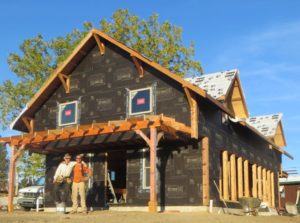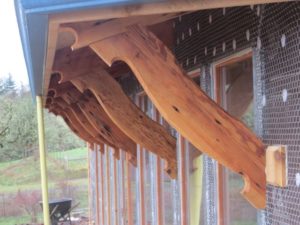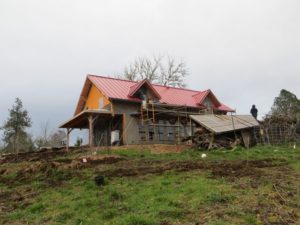
It’s hard to talk to people about beauty and building. Last fall, a friend of a friend came by to see our house-in-progress. He looked appreciatively at our modest but well-built structure — which I have been ornamenting by cutting curves in rafter tails and support brackets — and said, “why are you spending all this time to cut fancy shapes when you have a house to build?” Before I could reply, he said, almost to himself, “Oh, you’re an artist,” as if that explained otherwise aberrant behavior, like a diagnosis of disease.

For years I have taken offense at what felt to me like slights and judgements against “flaky” artists who can’t justify their economic existence because their output can’t be standardized, much less measured or licensed. It’s the view from economic laws of production and profit. All parts must justify their existence by contributing measurable (usually financial) benefit. No measure, no value; unmeasured work can’t add value and thus means unnecessary cost; cost must be minimized, houses must be built on time and on budget. Because “time equals money,” licensing and all its associated laws “add value” to the house and the economy — economic magic that also converts human creation of beauty from a necessity of gratitude into a “useless” luxury item. The other question almost everyone asks is: “when will you be done?” Because, of course, the “final product” is so much more important than the process, the projected ending so much more important than the NOW.

But as I have gone deeper into traditional hand-work and their associated arts — which don’t divorce ornament from utility — I have studied and begun to internalize an ancient truth — that beauty tells a universal story — of gratitude for life, and all that comes to us through the beauty and building of nature. That generosity makes no straight edges or square corners — it comes to us dressed in curves and colors; every feature fits, the way a beautiful nose fits in a beautiful face, or the way the leaves fit their trees. So in our works, for hundreds of thousands of years, individually and communally, we have tried to respond to beauty with beauty.
So I said to my guest, “A house is not just shelter — a box with a roof — a house tells a story. It can either tell the story of industrial production, which pillages and plunders the good green earth for profit and greed, faster and bigger, to glorify the victors of our international war for global empire — or it can tell the story of the beauty of the world that feeds us, shelters us, and gives us life. This beauty feeds ALL life, the strong and the weak, the fit and the unfit. And when we die, our bodies feed it in return. If we don’t tell the story, how can we even remember, much less repay the debt we incur at every step? The curves, the story, are a way of participating. You may as well ask, “why teach children to say thank you?”
He listened, politely, paused, at some length, and spoke of other things.
To divorce beauty from building makes both into sources of discomfort rather than comfort, sources of contention rather than sources of unity. This divorce is, to me, perhaps more dire than anything else we face — maybe, indeed, it is the source of all we’re facing?
But every day, our eyes, noses, fingers, toes, skin, ears, and hearts invite us to read a story of beauty. The grammar is written in curves, shapes, textures, and colors. The syntax is made of proportions and ratios. We come into the world speaking and understanding the language, sensitive to every nuance and subtlety. Current schooling ignores it, so we lose our fluency — along w/our sensitivities. But they return easily enough, through touch, taste, smell, awareness — but the hardest part to restore is the meaning, because meaning only exists through sharing.
However, because they’re so hard to convert to cash, much less manage for our own purposes, we barely give meanings the time of day. And while it might be possible to say, briefly, that we live for beauty, and that’s why it’s important to spend the extra time on this or that other detail of a building, I suspect we’ll have better luck if we can tell the stories about the homes and ancestries of every grain of sand in the plaster (the geology of mountains!); the source and age of the clay, and the names of the diggers, mixers, fermenters; the makers of the tools, and their ores and hammers and anvils; the forests where the trees grew, and the arms that cut them down.
In the same way that cutting down the forest causes springs to dry up, if we convert the flesh of the beautiful earth into a “product” — no matter how effectively we argue for it as “green,” “healthy,” or “sustainable,” — we lose the sources of meaning and beauty. Not that people shouldn’t be paid for the work they do in providing materials, labor, and substance, but that the challenge we face is not simply exchanging one product for another. It’s a matter of changing the whole story. Which means changing how we participate.
Every story requires introduction and context. Part of the work of beauty is making time to tell — and hear — the story. Traditionally, tellings are part of a general celebration, a meal or a feast where we’re all fed at many levels, encouraged to listen to and share the deeper meanings. I think we need those as much or more than we need the quantifiable things…
Our make-it-quick and get-it-cheap culture overlooks the spiritual value of beauty, the joy sparked by seeing/using/living in something crafted so carefully, finessed with love and skill, that reveals details over time to delight and relax us. We have too little experience with architecture built to last hundreds of years, to even know what we are missing. In other places, art is revered for the spiritual expression that it is, and is not so divorced from the rest of life. Thank you for bringing that reality to your home and our community.
Yes yes! Thanks, Laurie. The more I read, the more I believe that in most of our traditions art, expression, spirit, beauty — all were part of one whole. Health and wholeness come from the same place (and the same linguistic root). We do still know this. E = Mc2. But we’ve exchanged it for cash, power, status — illusions of control. Nevertheless, even now, we have choices, every day. Even small ones make a difference. Baking bread. Shopping at the farmer’s market. Learning to beat egg whites by hand. Walking instead of driving. Telling old stories to people who haven’t heard them. My favorite quote about art is from Ananda Coomaraswamy:
The basic error in what we have called the illusion of culture is the assumption that art is something to be done by a special kind of man, and particularly that kind of man whom we call a genius. In direct opposition to this is the normal and humane view that art is simply the right way of making things, whether symphonies or airplanes.
Manufacture is for use and not for profit. The artist is not a special kind of man [or woman], but every[one] who is not an artist in some field, every [one} without a vocation, is an idler. The kind of artist that [one] should be, carpenter, painter, lawyer, farmer, or priest, is determined by his own nature, in other words by his nativity. No [one] has a right to any social status who is not an artist
Nicely said. The Tlingit Indians who lived in Sitka Alaska, made beautiful household objects, for their daily use, all decorated from the largest (houses), to spoons and sewing needles. They are now in the museum in Sitka, and I have often wondered what ones life was like when everything you used or touched was a thing of beauty. It was an interesting culture that the Westerners who conquered them had no patience for. The Russians who came later were more sympathetic to it. I may have some books of their designs that I will send you.
Hope you had a nice trip to the UK, Kristine
Great Article!
“Why teach children to say thank you?” Perfect.